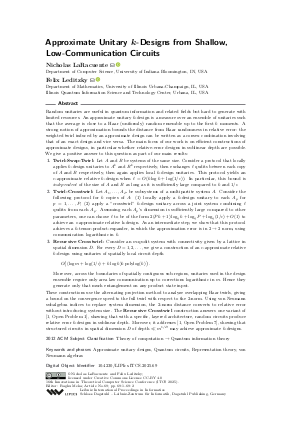LIPIcs.ITCS.2025.69.pdf
- Filesize: 406 kB
- 2 pages

 Creative Commons Attribution 4.0 International license
Creative Commons Attribution 4.0 International license

Random unitaries are useful in quantum information and related fields but hard to generate with limited resources. An approximate unitary k-design is a measure over an ensemble of unitaries such that the average is close to a Haar (uniformly) random ensemble up to the first k moments. A strong notion of approximation bounds the distance from Haar randomness in relative error: the weighted twirl induced by an approximate design can be written as a convex combination involving that of an exact design and vice versa. The main focus of our work is on efficient constructions of approximate designs, in particular whether relative-error designs in sublinear depth are possible. We give a positive answer to this question as part of our main results:
1. Twirl-Swap-Twirl: Let A and B be systems of the same size. Consider a protocol that locally applies k-design unitaries to A^k and B^k respectively, then exchanges l qudits between each copy of A and B respectively, then again applies local k-design unitaries. This protocol yields an ε-approximate relative k-design when l = O(k log k + log(1/ε)). In particular, this bound is independent of the size of A and B as long as it is sufficiently large compared to k and 1/ε.
2. Twirl-Crosstwirl: Let A_1, … , A_P be subsystems of a multipartite system A. Consider the following protocol for k copies of A: (1) locally apply a k-design unitary to each A_p for p = 1, … , P; (2) apply a "crosstwirl" k-design unitary across a joint system combining l qudits from each A_p. Assuming each A_p’s dimension is sufficiently large compared to other parameters, one can choose l to be of the form 2 (Pk + 1) log_q k + log_q P + log_q(1/ε) + O(1) to achieve an ε-approximate relative k-design. As an intermediate step, we show that this protocol achieves a k-tensor-product-expander, in which the approximation error is in 2 → 2 norm, using communication logarithmic in k.
3. Recursive Crosstwirl: Consider an m-qudit system with connectivity given by a lattice in spatial dimension D. For every D = 1, 2, …, we give a construction of an ε-approximate relative k-design using unitaries of spatially local circuit depth O ((log m + log(1/ε) + k log k ) k polylog(k)). Moreover, across the boundaries of spatially contiguous sub-regions, unitaries used in the design ensemble require only area law communication up to corrections logarithmic in m. Hence they generate only that much entanglement on any product state input.
These constructions use the alternating projection method to analyze overlapping Haar twirls, giving a bound on the convergence speed to the full twirl with respect to the 2-norm. Using von Neumann subalgebra indices to replace system dimension, the 2-norm distance converts to relative error without introducing system size. The Recursive Crosstwirl construction answers one variant of [Harrow and Mehraban, 2023, Open Problem 1], showing that with a specific, layered architecture, random circuits produce relative error k-designs in sublinear depth. Moreover, it addresses [Harrow and Mehraban, 2023, Open Problem 7], showing that structured circuits in spatial dimension D of depth << m^{1/D} may achieve approximate k-designs.
Feedback for Dagstuhl Publishing